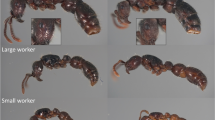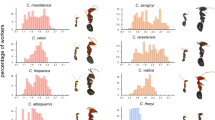Abstract
Evolution of caste is a central issue in the biology of social insects. Comparative studies on their morphology so far suggest the following three patterns: (1) a positive correlation between queen–worker size dimorphism and the divergence in reproductive ability between castes, (2) a negative correlation among workers between morphological diversity and reproductive ability, and (3) a positive correlation between queen–worker body shape difference and the diversity in worker morphology. We conducted morphological comparisons between castes in Pachycondyla luteipes, workers of which are monomorphic and lack their reproductive ability. Although the size distribution broadly overlapped, mean head width, head length, and scape length were significantly different between queens and workers. Conversely, in eye length, petiole width, and Weber’s length, the size differences were reversed. The allometries (head length/head width, scape length/head width, and Weber’s length/head width) were also significantly different between queens and workers. Morphological examinations showed that the body shape was different between queens and workers, and the head part of workers was disproportionately larger than that of queens. This pattern of queen–worker dimorphism is novel in ants with monomorphic workers and a clear exception to the last pattern. This study suggests that it is possible that the loss of individual-level selection, the lack of reproductive ability, influences morphological modification in ants.




Similar content being viewed by others
References
Bolton B (2003) Synopsis and classification of Formicidae. Mem Am Entmol Inst 71:1–370
Bourke AFG, Franks NR (1995) Social evolution in ants. Princeton University Press, Princeton, New Jersey
Brady SG, Schultz TR, Fisher BL, Ward PS (2006) Evaluating alternative hypotheses for the early evolution and diversification of ants. Proc Natl Acad Sci U S A 103:18172–18177
Breed MD (2002) Allometry in the giant tropical ant, Paraponera clavata. Insectes Soc 49:125–128
Falster DS, Warton DI, Wright IJ (2003) (S)MATR: standard major axis tests and routines, Version 1.0. http://www.bio.mg.edu.au/ecology/SMATR
Fjerdingstad EJ, Crozier RH (2006) The evolution of worker caste diversity in social insects. Am Nat 167:390–400
Fraser VS, Kaufmann B, Oldroyd BP, Crozier RH (2000) Genetic influence on caste in the ant Camponotus consobrinus. Behav Ecol Sociobiol 47:188–194
Frumhoff PC, Ward PS (1992) Individual-level selection, colony-level selection, and the association between polygyny and worker monomorphism in ants. Am Nat 139:559–590
Haskins CP, Haskins EF (1950) Note on the method of colony foundation of the ponerine ant Brachyponera (Euponera) lutea Mayr. Psyche 57:1–9
Hölldobler B, Wilson EO (1990) The ants. Harvard University Press, Cambridge, Massachusetts
Jeanne RL (1980) Evolution of social behavior in the Vespidae. Annu Rev Entomol 25:371–395
Jeanne RL, Graf CA, Yandell BS (1995) Non-sized-based morphological castes in a social insect. Naturwissenchaften 82:296–298
Kaspari M (1993) Body size and microclimate use in neotropical granvirous ants. Oecologia 96:500–507
Kikuchi T, Higashi S, Murakami T (1999) A morphological comparison of alates between monogynous and polygynous colonies of Myrmica kotokui in northernmost Japan. Insectes Soc 46:250–255
Kikuchi T, Tomizuka F, Higashi S (2000) Reproductive strategy in orphaned colonies of Myrmica kotokui Forel, the Japanese species of the M. ruginodis complex (Hymenoptera Formicidae). Insectes Soc 47:343–347
Kikuchi T, Tsuji K, Ohnishi H, Le Bleton J (2007) Caste-biased acceptance of non-nestmates in a polygynous ponerine ant. Anim Behav 73:559–565
Moreau CS, Bell CD, Vila R, Archibald SB, Pirece NF (2006) Phylogeny of the ants: diversification in the age of angiosperms. Science 312:103–104
Onoyama K (1999) A new and a newly recorded species of the ant genus Amblyopone (Hymenoptera: Formicidae) from Japan. Entomol Sci 2:157–161
Oster GF, Wilson EO (1978) Caste and ecology in the social insects. Princeton University Press, Princeton, New Jersey
Paul J (2001) Mandible movements in ants. Comp Biochem Phys A 131:7–20
Peeters C (1991) The occurrence of sexual reproduction among ant workers. Biol J Linn Soc 44:141–152
Peeters C (1993) Monogyny and polygyny in ponerine ants with or without queens. In: Keller L (ed) Queen number and sociality in insects. Oxford University Press, Oxford, pp 234–261
Peeters C (1997) Morphologically ‘primitive’ ants: comparative review of social characters, and the importance of queen–worker dimorphism. In: Choe JC, Crespi BJ (eds) Social behavior in insects and arachnids. Cambridge University Press, Cambridge, pp 372–391
Peeters C, Ito F (2001) Colony dispersal and the evolution of queen morphology in social Hymenoptera. Annu Rev Entomol 46:601–630
Peeters C, Higahsi S, Ito F (1991) Reproduction in ponerine ants without queens: monogyny and exceptionally small colonies in the Australian Pachycondyla sublaevis. Ethol Ecol Evol 3:145–152
Powell S, Franks NR (2005) Caste evolution and ecology: a special worker for novel prey. Proc R Soc B 272:2173–2180
Rheindt FE, Strehl CP, Gadau J (2005) A genetic component in the determination of worker polymorphism in the Florida harvester ant Pogonomyrmex badius. Insectes Soc 52:163–168
Shima SN, Yamane S, Zucchi R (1994) Morphological caste differences in some neotropical swarm-founding Polistinae wasps I. Apoica flavissima (Hymenoptera, Vespidae). Jpn J Entomol 62:811–822
Shima SN, Yamane S, Zucchi R (1996) Morphological caste differences in some neotropical swarm-founding Polistinae wasps I. Polybia dimidiata (Hymenoptera, Vespidae). Jpn J Entomol 64:131–144
Sokal RR, Rohlf EJ (1995) Biometry. W. H. Freeman and Company, New York
Taylor RW (1978) Nothomyrmecia macrops: a living-fossil ant rediscovered. Science 201:979–985
Wheeler DE (1986) Developmental and physiological determinants of caste in social Hymenoptera: evolutionary implications. Am Nat 128:13–34
Wheeler DE (1991) The developmental basis of worker caste polymorphism in ants. Am Nat 138:1218–1238
Yamauchi K, Yoshida T, Ogawa T, Itoh S, Ogawa Y, Jimbo S, Imai HT (2001) Spermatogenesis of diploid males in the formicine ant, Lasius sakagami. Insectes Soc 48:28–32
Acknowledgments
We thank T. Miura and S. Koshikawa for helpful advice and M. Suwabe for assistance with the field work. This work was supported in part by grants-in-aid from the Japan Ministry of Education, Science and Culture (17207003 to S. Higashi and 17657029, 18370012 and 18047017 to K. Tsuji) and Research Fellowships for Young Scientists from the Japan Society for the Promotion of Science to T. Kikuchi.
Author information
Authors and Affiliations
Corresponding author
Rights and permissions
About this article
Cite this article
Kikuchi, T., Miyazaki, S., Ohnishi, H. et al. Small queens and big-headed workers in a monomorphic ponerine ant. Naturwissenschaften 95, 963–968 (2008). https://doi.org/10.1007/s00114-008-0414-8
Received:
Revised:
Accepted:
Published:
Issue Date:
DOI: https://doi.org/10.1007/s00114-008-0414-8




